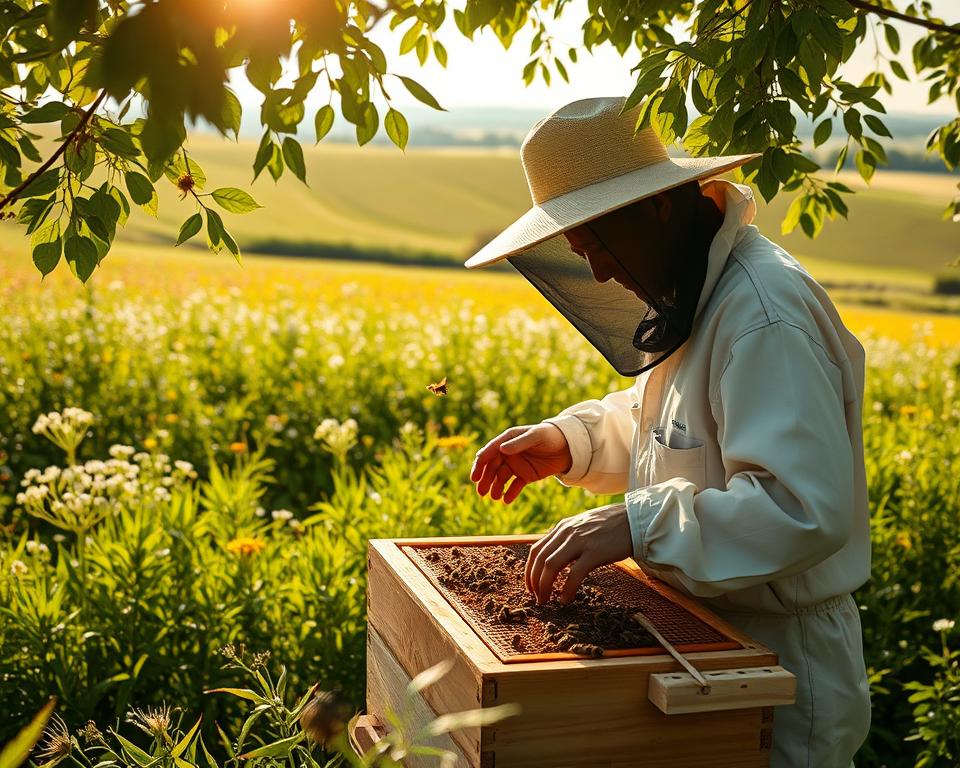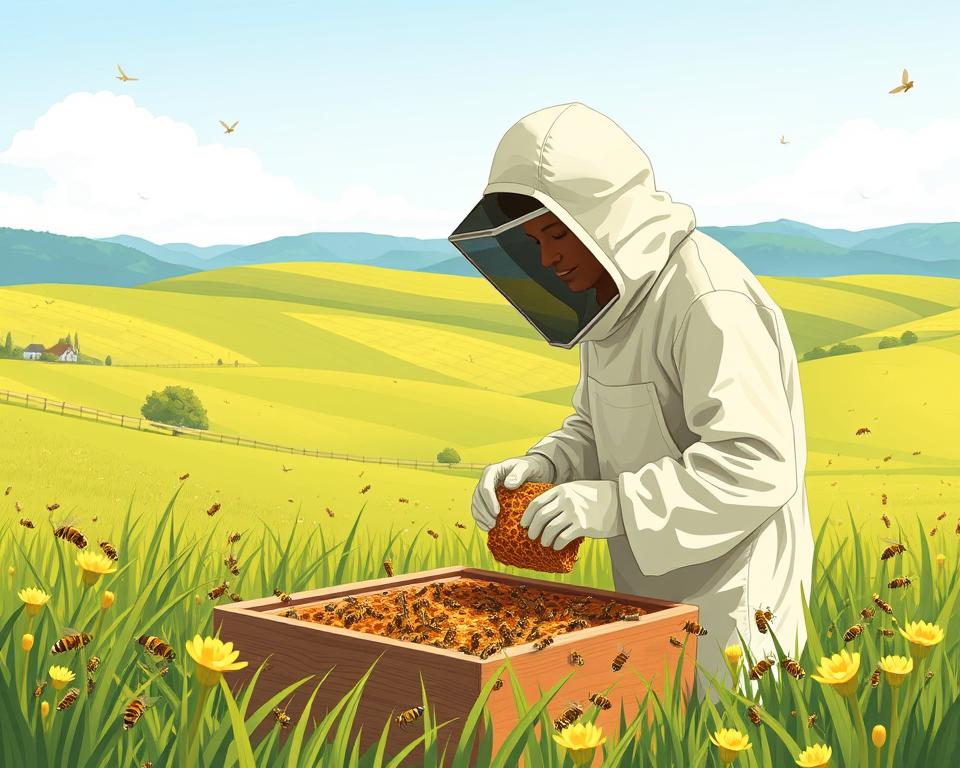Did you know bees pollinate over 1/3 of the world’s crops? This includes coffee, almonds, and apples. This fact shows how crucial bees are to our ecosystem and food supply. Starting beekeeping can be fascinating and rewarding. It’s important to know the basics for a good start.
In this guide, I’ll show you how to start beekeeping. We’ll cover the key things you need to know. From the importance of bees to choosing the right equipment, we’ll go over everything you need to get started.
Key Takeaways
- Understanding the basics of beekeeping is key for a good start.
- Bees are vital for pollinating crops and keeping our ecosystem healthy.
- Choosing the right equipment is important for beekeeping.
- Beekeeping takes a lot of time and dedication.
- Joining a beekeeping community can help beginners a lot.
Understanding Beekeeping Basics
Starting my beekeeping journey, I learned the basics are key. Beekeeping is a complex hobby that needs knowledge of bee biology, hive management, and honey making.
What is Beekeeping?
Beekeeping, or apiculture, is keeping bee colonies in apiaries for honey and wax. It’s about managing the bees’ needs for food, shelter, and protection from pests and diseases.
Importance of Bees
Bees are vital for pollination, which plants need to reproduce. Without bees, our food supply would suffer, as many crops need bees to pollinate. Bees also pollinate flowers and other plants.
Bees are more than just pollinators. They symbolize ecological health. Keeping bees healthy helps our environment. Beekeepers support local ecosystems by maintaining healthy bee colonies.
Common Beekeeping Terms
Knowing beekeeping terms is important for joining the beekeeping community. Some key terms include:
- Apiary: A place for beehives.
- Nucleus colony (nuc): A small bee colony for starting a new hive.
- Honey super: A box for storing honey.
- Brood: The eggs and larvae in a hive.
Learning these terms helps you talk with other beekeepers and make better beekeeping choices.
Choosing the Right Location for Your Hives
The spot where you place your beehives is key to your bees’ health and work. As you begin beekeeping, think about several important factors. These will help your colony thrive.
Ideal Conditions for Hives
Look for certain conditions when picking a spot for your hives. Adequate sunlight is a must, keeping the hive warm. Also, good air flow is important to avoid moisture buildup and disease.
Having a reliable water source nearby is also key. Bees need water for drinking and cooling the hive.
The area should be flat and dry. Avoid places that might flood or have standing water. This prevents hive flooding and disease risks.
“The right apiary site can make all the difference in the health and productivity of your bees. A well-chosen location can lead to a bountiful harvest and a thriving colony.”
Local Regulations to Consider
Before choosing a spot, learn about local beekeeping rules. This includes zoning laws and registration of beehives. Check with local authorities to follow these rules.
Also, know about neighborhood ordinances that might impact your beekeeping. Following these rules helps you avoid problems and enjoy beekeeping.
By considering both the best conditions for your hives and local rules, you can pick a great spot. This will help your bees and set you up for success in beekeeping.
Selecting Your Beehive Type
The type of beehive you choose can greatly affect your beekeeping journey. There are many options, each with its own features. It’s important to know what each offers to make the best choice.
Top Bar Hives
Top Bar Hives are loved by many beekeepers for their simplicity. They have a single box with bars for the bees to build their comb. This setup helps mimic the bees’ natural environment.
Advantages of Top Bar Hives:
- Less expensive to start
- Easier to manage for beginners
- Promotes natural comb building
Langstroth Hives
Langstroth Hives are widely used in commercial beekeeping. They have a vertical design with stacked boxes. This makes it easy to add more boxes and harvest honey.
Key Features of Langstroth Hives:
- High honey production
- Efficient use of space
- Easy to inspect and manage
Warre Hives
Warre Hives, also known as “People’s Hive,” aim to replicate bees’ natural habitat. They are vertical hives with boxes stacked like Langstroth Hives but have a unique internal design.
Benefits of Warre Hives:
- Minimal maintenance
- Natural, low-intervention beekeeping
- Good for small-scale beekeeping
Factors to Consider
Choosing a beehive type involves several factors. Your budget, space, and the bees you plan to keep are key. Also, think about how much maintenance you’re ready for and your honey goals.
By weighing these factors and understanding each beehive type, you can choose wisely. Whether you’re new or experienced, picking the right beehive is vital. It ensures a rewarding and successful beekeeping journey.
Acquiring Your Bees
It’s time to get your bees! I’ll show you how to buy bees and learn about different species. Getting bees is a big step in beekeeping. Making smart choices will help your apiary succeed.
Where to Buy Bees
You can buy bees from local bee suppliers or online. Local suppliers give you bees that fit your area’s weather. Online shops have many species and packages. But, always check the seller’s reputation for healthy bees.
- Local bee suppliers: They offer advice for your area and have bees ready for it.
- Online retailers: They have a wide selection, but read reviews first.
- Bee associations and clubs: Members might sell bees or know someone who does.
Understanding Different Bee Species
There are many bee species, each with its own traits. European honey bees (Apis mellifera) are popular for their honey and calm nature. Carniolan bees are known for being gentle and disease-resistant. Knowing about each species helps you choose the right ones for your goals.
| Bee Species | Characteristics | Honey Production |
|---|---|---|
| European Honey Bees | Gentle, high honey production | High |
| Carniolan Bees | Disease resistant, gentle | Moderate |
| Italian Bees | High honey production, prolific | High |

“The best bee is not necessarily the one that produces the most honey, but the one that thrives in your local environment.”
Choosing the right bees is key to a great beekeeping journey. Whether starting or growing, knowing your options helps you make the best choice for your bees and goals.
Essential Beekeeping Equipment
To manage bees safely and efficiently, beekeepers need a range of essential equipment. As a beginner, it’s important to know the different types of gear needed for beekeeping.
Protective Gear
Protective gear is key to avoiding bee stings. A beekeeping suit, including a veil and gloves, offers full protection. “A good beekeeper always wears protective gear,” says experienced beekeeper, John Smith.
“It’s not just about the bees; it’s about your safety and confidence when working with them.”
A veil protects your face and neck from stings. Gloves, made of durable material, prevent stings on your hands. When picking protective gear, look for quality and durability.
Tools for Hive Maintenance
Regular hive maintenance is key for your bees’ health. Essential tools include a smoker and a hive tool. These tools make managing your bees easier.
- Smoker: Calms bees by producing smoke, making it easier to inspect the hive.
- Hive Tool: Used for opening the hive, scraping propolis, and other tasks.
Honey Harvesting Equipment
For those interested in harvesting honey, specific equipment is needed. A honey extractor is used to extract honey from honeycombs without damaging them. Also, honey filters help purify the honey before bottling.
As beekeeper, Jane Doe, notes, “Using the right equipment for honey harvesting makes a significant difference in the quality of the honey.” The right equipment ensures that the honey is clean and of high quality.
Learning the Art of Bee Management
To keep your bees healthy and productive, learning bee management is key. It’s about regular checks, watching their health, and giving them the care they need. This ensures your bees do well.
Regular Hive Inspections
Checking your hive often is vital. It helps you see if your bees are sick, have pests, or need food. You should check every 7-10 days when they’re busy.
Look for the queen, food, water, and how active the bees are. This lets you fix problems early and keep your bees healthy.

Monitoring Bee Health
Watching your bees for sickness or stress is important. Look out for varroa mites, American foulbrood, and nosema. Spotting these early helps you act fast.
For more on starting beekeeping and bee health, check this resource. It has lots of helpful info.
Feeding Bees
Feeding your bees is sometimes needed. This is when there’s little nectar or they’re struggling to find food. Sugar syrup and pollen are common feeds.
Feeding at the right time and amount is key. A 1:1 sugar syrup boosts brood, while 2:1 syrup helps during food shortages.
Understanding Bee Behavior
Every beekeeper needs to know about bee behavior. It’s key to manage bees well. You must understand their social structure and how they act.
Worker Bees vs. Queen Bees
In a bee colony, there are three main types: the queen bee, worker bees, and drones. Worker bees are female and do a lot of work. They forage, care for young, and keep the hive in order.
The queen bee is the biggest bee and lays eggs. She can live up to five years. Worker bees, on the other hand, live about six weeks in summer. The queen’s pheromones control the worker bees’ actions.
| Characteristics | Worker Bees | Queen Bee |
|---|---|---|
| Lifespan | 6 weeks (summer) | Up to 5 years |
| Responsibilities | Foraging, caring for young, hive maintenance | Laying eggs |
Swarming and Its Causes
Swarming happens when bees leave the hive to start a new one. This usually happens when the hive is too full or the queen’s pheromones drop.
To stop swarming, beekeepers can:
- Watch the colony’s size and split it if needed
- Make sure the hive has enough air
- Change the queen if she’s old or not doing well
For more on starting beekeeping and managing colonies, check out https://theapiarist.org/how-to-start-beekeeping/. It’s a detailed guide.
Strategies for Successful Honey Production
Producing great honey is a mix of science and art for beekeepers. I’ve learned that it takes skill and knowledge. It’s not just about keeping bees; it’s about making honey too.
To make good honey, you need to know how to harvest it right. Honey is ready when the cells are capped with wax. This means the water content is just right.
Best Practices for Honey Harvesting
Here are some tips for harvesting honey:
- Use the right tools, like a honey extractor, to get honey without harming the comb.
- Smoke your bees to keep them calm before opening the hive, which lowers sting risk.
- Harvest honey in the morning or early afternoon when most forager bees are out.
- Make sure to leave enough honey for the bees to get through winter. They need it for food.
“The key to successful honey production lies in understanding the needs of your bees and acting appropriately.” This is what a famous beekeeper says.
Seasonal Considerations
Seasons change how much honey bees make. In peak nectar flow times, bees make more honey. But in winter, they use honey for energy, so they need enough.
To get more honey, beekeepers should:
- Watch the nectar flow and adjust their care for the bees.
- Get bees ready for winter by making sure they have enough honey and a healthy queen.
- Keep bees healthy by fighting pests and diseases, which can hurt honey production.
By following these tips and watching the seasons, you can make more honey. I’ve learned that success comes from knowing your bees, using the right tools, and being patient.
Dealing with Pests and Diseases
Effective beekeeping is more than just making honey. It’s also about keeping your bees safe from pests and diseases. As a beekeeper, knowing the common threats and how to fight them is key.
Common Bee Pests
Bee colonies face many pests, like varroa mites and small hive beetles. Varroa mites harm bees by feeding on their blood, making them weak. Small hive beetles damage honey and bee brood.
To tackle these pests, inspect your hives often and watch for signs of trouble. Integrated pest management (IPM) strategies work well. They include using medicine, keeping hives clean, and splitting colonies to fight varroa mites.
Preventative Measures
Prevention is vital in beekeeping. Keep hives clean and well-ventilated, avoid overcrowding, and give bees diverse food. Regular disease checks and quick action can stop problems from spreading.
By knowing beekeeping basics and staying alert, you can lower pest and disease risks. This care helps your bees stay healthy and your colony to grow strong.
Connecting with the Beekeeping Community
Connecting with other beekeepers has really helped me understand this hobby better. As I got more into beekeeping, I saw how important it is to be part of a community. This community shares knowledge, resources, and support.
One great way to meet other beekeepers is through local beekeeping associations. These groups let beekeepers meet, share ideas, and learn from each other’s experiences.
Local Beekeeping Associations
Local beekeeping associations are great for both new and experienced beekeepers. They offer chances to network, learn, and get support. By joining, you can learn new things, get tips, and get help when you need it.
- Attend meetings and workshops to learn from experienced beekeepers
- Participate in local events to promote beekeeping and educate the public
- Connect with other beekeepers to share knowledge and resources
Online Resources and Forums
Online resources and forums are also key for beekeepers. Online communities are where you can ask questions, share experiences, and keep up with beekeeping news.
Popular online spots for beekeepers include social media groups, beekeeping forums, and online courses. These are super helpful for beginners or those in areas with few local beekeepers.
By joining both local and online beekeeping groups, you can improve your beekeeping skills. You’ll also stay updated on the latest beekeeping practices. Plus, you’ll help the beekeeping community grow and develop.
Continuing Your Beekeeping Education
Beekeeping is a journey that never ends. It takes dedication and a readiness to learn new things. As you begin, it’s key to keep up with the latest methods and tools.
Recommended Reading for Beekeepers
There are many books and guides for beekeepers. They cover everything from the basics to advanced techniques. These resources are great for both new and seasoned beekeepers.
It’s important to learn the basics first. Knowing what you need for beekeeping is essential.
Workshops and Courses for Beekeepers
Workshops and courses offer hands-on learning. They let you learn from experts. Local beekeeping groups and online platforms have these programs.
They teach you about managing hives, making honey, and controlling pests. These resources help you get better at beekeeping and keep up with new practices.
